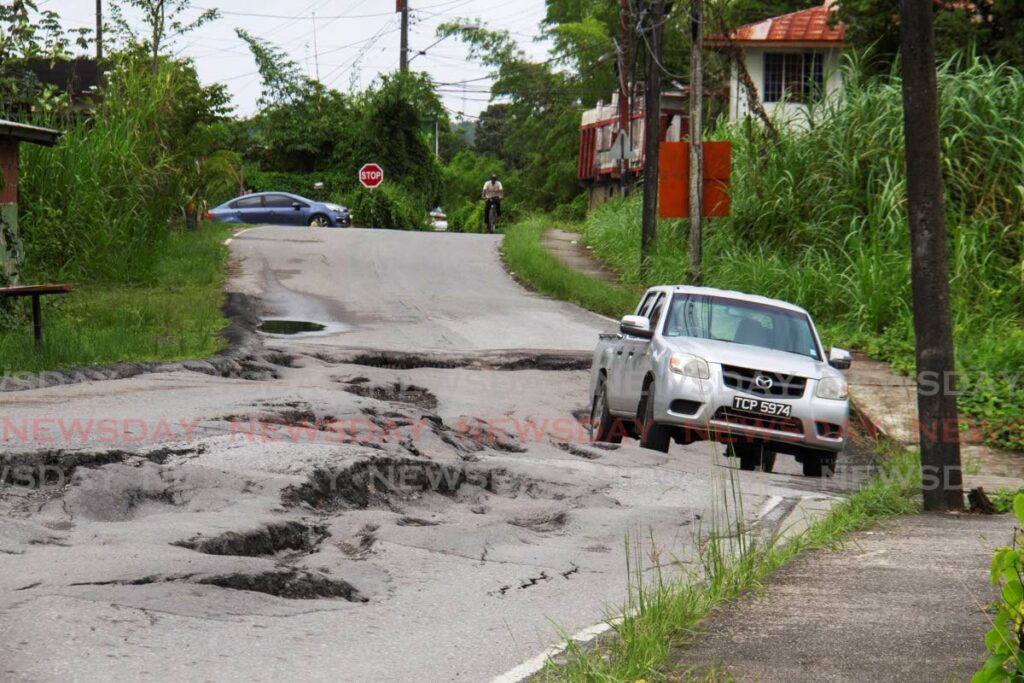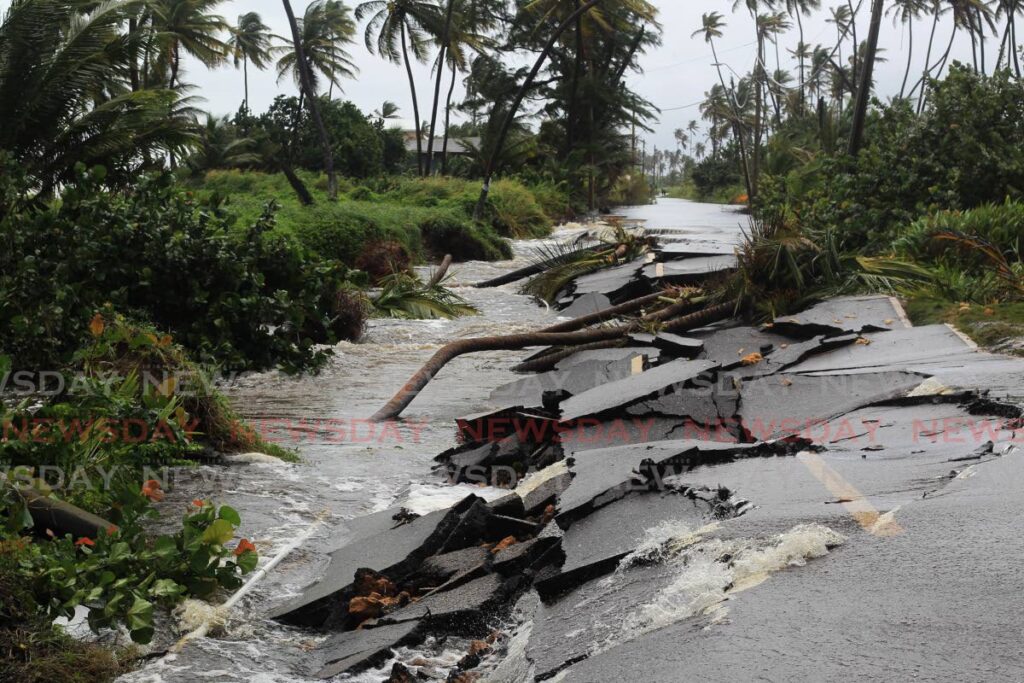Engineering experts: No quick fix for collapsing road network

IN THE COMING months, the Ministry of Works and Transport will embark on a mammoth task of rebuilding collapsing roads throughout the country, some of which are threatening to cut off access to communities.
After two years of reduced maintenance and roadworks owing to the focus on combating the spread of covid19, the network of roads felt the full wrath of devastating floods, landslides and shifting soil.
The Manzanilla/Mayaro Road, which links Sangre Grande to Mayaro, had to be closed off to a constant rush of water from the Nariva Swamp, leaving large chunks of asphalt unearthed in several areas. Other villagers in north, east, central and south Trinidad protested after major road linkages in their areas became near-impassable.
Sunday Newsday spoke to experts in the field of civil engineering and planning to explore some of the solutions to the recurring problem, which, if deployed, will save taxpayers in the long run.
Engineering consultant Adesh Surujnath suggested one of the first steps was to determine the remaining life of the road by using either the Benkelman Beam Test or Falling Weight Deflectometer Test. Both are used to evaluate pavements and pavement-layer stiffness, before determining the appropriate repair strategy – reconstruct entirely, mill and add a layer or asphalt or even patch the existing pothole.
Surujnath believes road engineers are not making that initial assessment before repaving roads.
"You do not see a proper survey being done on the road.
"How the road failed should indicate what the repair strategy should be in that location. You may have to do an asphalt patch, you may have to dig out the foundation and put back in all the different layers and then the asphalt. But you have to do a proper survey on the road, and from what I have seen in the repairs, I am not seeing that being done. It is not evident to me," Surujnath said.
Another major factor, he said, was inadequate drainage or failure to maintain roadside drains, which was critical to stop water from saturating the layers of the road foundation, and depending on the soil type, can result in a pothole or worse, shifting of the road.

He said the use of weighbrigdes can check whether trucks, often overloaded with aggregate, are carrying the loads for which they are licensed, and this can help reduce damage to the road network.
Civil engineer Dr Don Samuel recommended that the ministry prioritise the implementation of sustainable engineering solutions to landslips and floods which have negatively affected the country's roads.
He too identified landslips and floods as the root causes of repeated road failure and said if these issues are not addressed urgently, any road repairs would be both uneconomical and futile. The required maintenance regime must include annual inspections of roads, bridges and associated drainage infrastructure to ensure they remain functional as designed. Construction supervision of contractors is also essential to ensure roads are repaired/built as designed. The historical practice of repairing roads before local/general elections must stop, as roads need to be checked and repaired annually, he said.
Samuel said once the construction solutions to address landslips and floods are in place then the ministry should consider two categories of road rehabilitation:
1) roads which can be repaired in the short term and
2) roads which need to be rebuilt in the long term.
The first category includes roads which have minor defects, few depressions and few potholes. The second category is made up of roads which have major defects, several depressions and many potholes, thus creating unsafe driving conditions. In his opinion, emergency funding should be released immediately to address roads in the second category.
Additionally, the ministry must consider, as part of the engineering approach, the following significant actions which influence the longevity of roads:
1) a study of the quality/availability of local road-building materials
2) undertaking independent engineering reviews of proposed road designs
3) increasing the frequency of laboratory testing of road materials (eg, Marshall and soil tests)
4) increasing construction supervision using qualified/experienced engineers/technicians/consultants
5) increasing the frequency of post-construction surveys to ensure compliance with standards
6) increasing transparency in procuring road contracts to ensure value for money
7) ensuring the use of relevant engineering codes, standard and specifications
8) researching the use of non-conventional materials/methods for road construction.
Samuel suggested before any work is done to restore or rebuild the Manzanilla/Mayaro Road, the primary step should be root-cause analysis.
"If we do not determine why this situation has occurred, we would be doomed to another failure. Sections of this road failed in 2014 and eight years later in 2022. The road was subjected to intense flooding on both occasions which undermined the sub-layers of the road, leading to major damage of the road structure."
Samuel said video footage showed water flowing from the Nariva Swamp to the sea, and suggested wetland experts be asked to determine if the swamp is receiving an additional volume of stormwater from unknown sources.
"If this theory is confirmed via research, then it is recommended to consider the installation of a combination of retention ponds and/or major drainage channels on the western edge of the road to accept the stormwater.
"This is a significant cost, but the cost due to physical damage, transport losses and reduced road-network connectivity is even higher.
"Once the flooding issue is addressed, the road can be rebuilt with a re-engineered pavement structure. Some sections of the road could be elevated using built up embankments, but these embankments must be protected, or else we would have a repeat of the disaster. "
Asked whether there should be a restriction on heavy vehicles using rural roads, Samuel said the better option was to re-engineer rural roads to accommodate them.
"While this comes at a significant cost, it must be done given accelerated settlement and development patterns in the country. Once the roads are re-engineered, then legislation could be enacted to determine what roads can be used by heavy-T or extra-heavy-T vehicles. Highways and major secondary roads can be used by heavy-T and extra-heavy-T vehicles once they are maintained. These vehicles should avoid frequent use of the rural roads except in specific circumstances such as emergencies.
"The issue which arises is monitoring and enforcement of any new law pertaining to restrictions. It is difficult to assign liability to the owner of a heavy-T and extra-heavy-T vehicle, given that the road is subject to loads from other vehicle classifications.
"It is now becoming critical to maintain/re-engineer all roads in the local network, given that all classifications of vehicles are accessing both rural and urban areas."
Dr Asad Mohammed, an urban and regional planner, said establishing an alternative road network is critical, as well as surface-water management and watershed management.
Mohammed believes the infrastructure networks "will get worse rather than better," because the infrastructure was not developed to be susceptible to increasing acts of climate change and natural events.
"We cannot sit down and wait for serendipity to figure it out."
He suggested the country has to be ahead of rather than behind the game.
Mohammed agreed with the comments of the Prime Minister (a geologist) that large areas, particularly in the south of Trinidad, had expansive soils which are more susceptible to geological problems.
He said the segments of the road network in parts of the country had evolved from tasker roads, estate roads, cocoa roads and traces in the Northern Range without having the proper base and foundations, and over the years layers of asphalt were added without the adequate base design.
"We know about how we like to pave, especially around election time, so we get a nice-looking tarmac for a month or two, and pretty soon it starts to deteriorate. Why? Because first of all, the sub-base was not adequate, the underlying geological conditions were problematic, we did not take care properly about drainage: that is the major killer. Very often, many of the minor roads are developed by local government, without proper engineering designs, so the design and supervision were inadequate," he said.
"It is not simply an engineering issue, it is a land-use issue, it is an accessibility issue, it is a surface-water issue. All of those things have to be pulled together. It is not a Ministry of Works problem."
Mohammed asked what the authorities have been doing up until now, that the country now finds itself in a state of calamity where it has to start at first base, rather than have existing programmes in place .
"If that is where we are, certainly let us start long- and medium-term thinking for resilience, not recovery only: how to make our infrastructure resilient for what we know is coming, in terms of climate events and so on," he concluded.


Comments
"Engineering experts: No quick fix for collapsing road network"